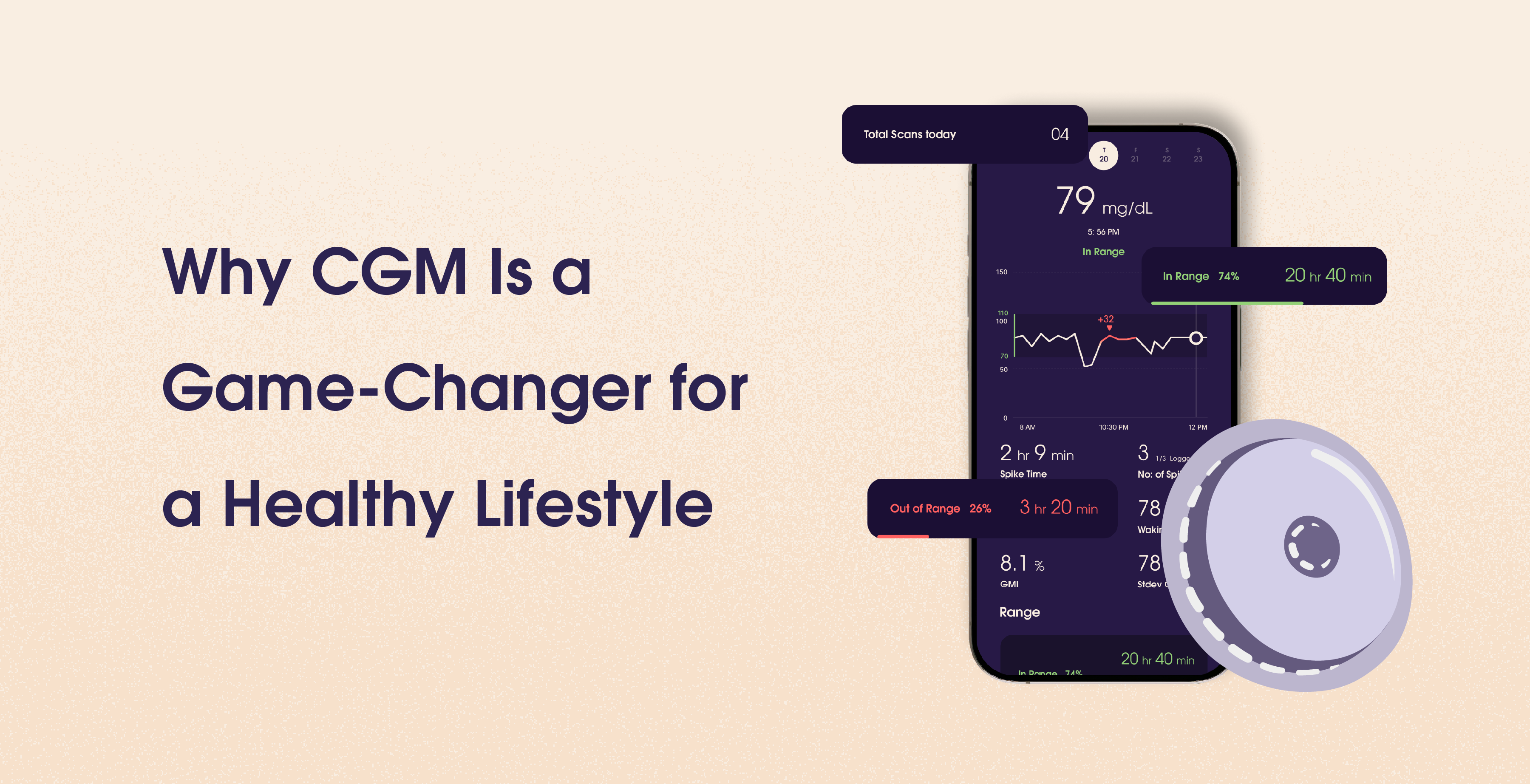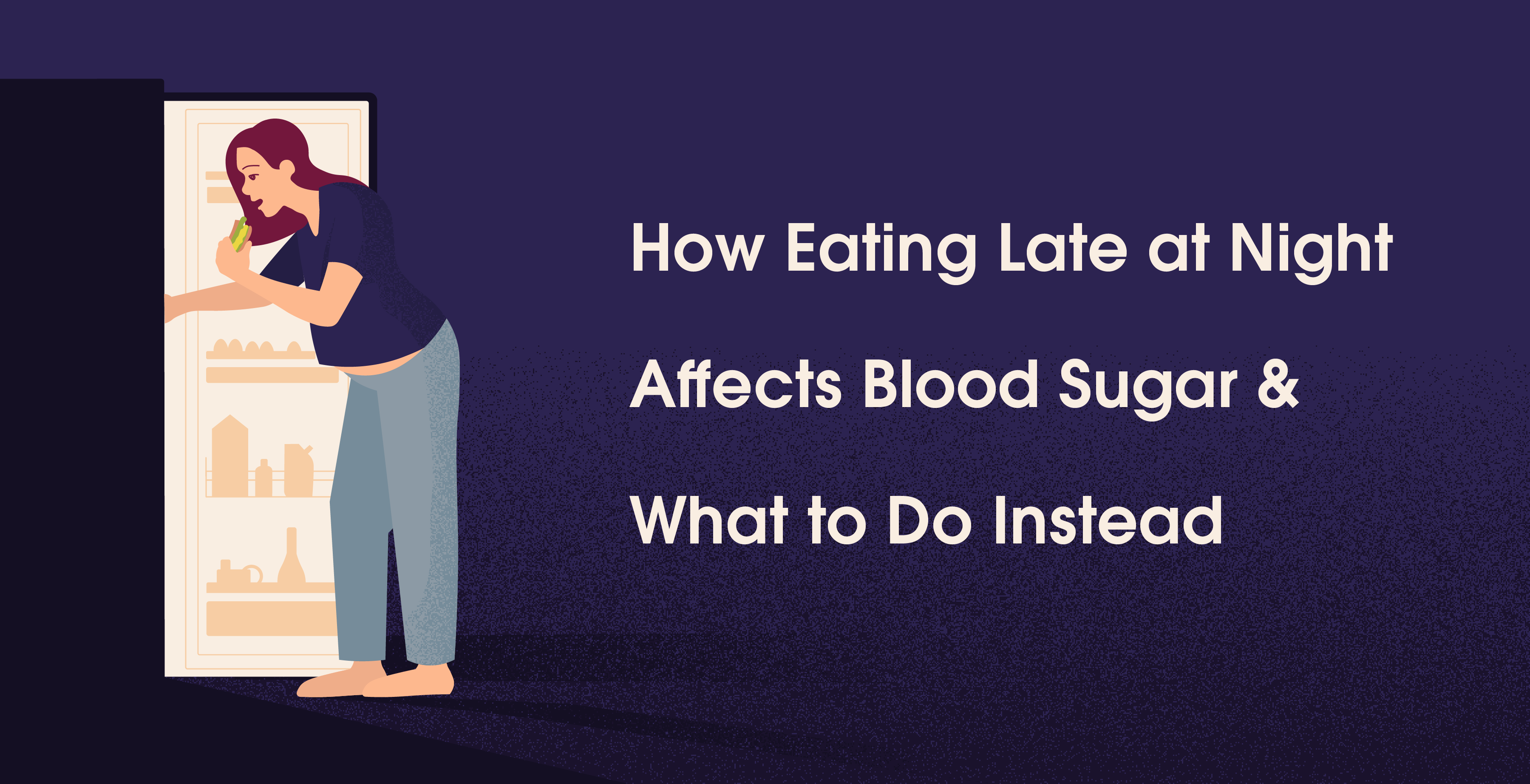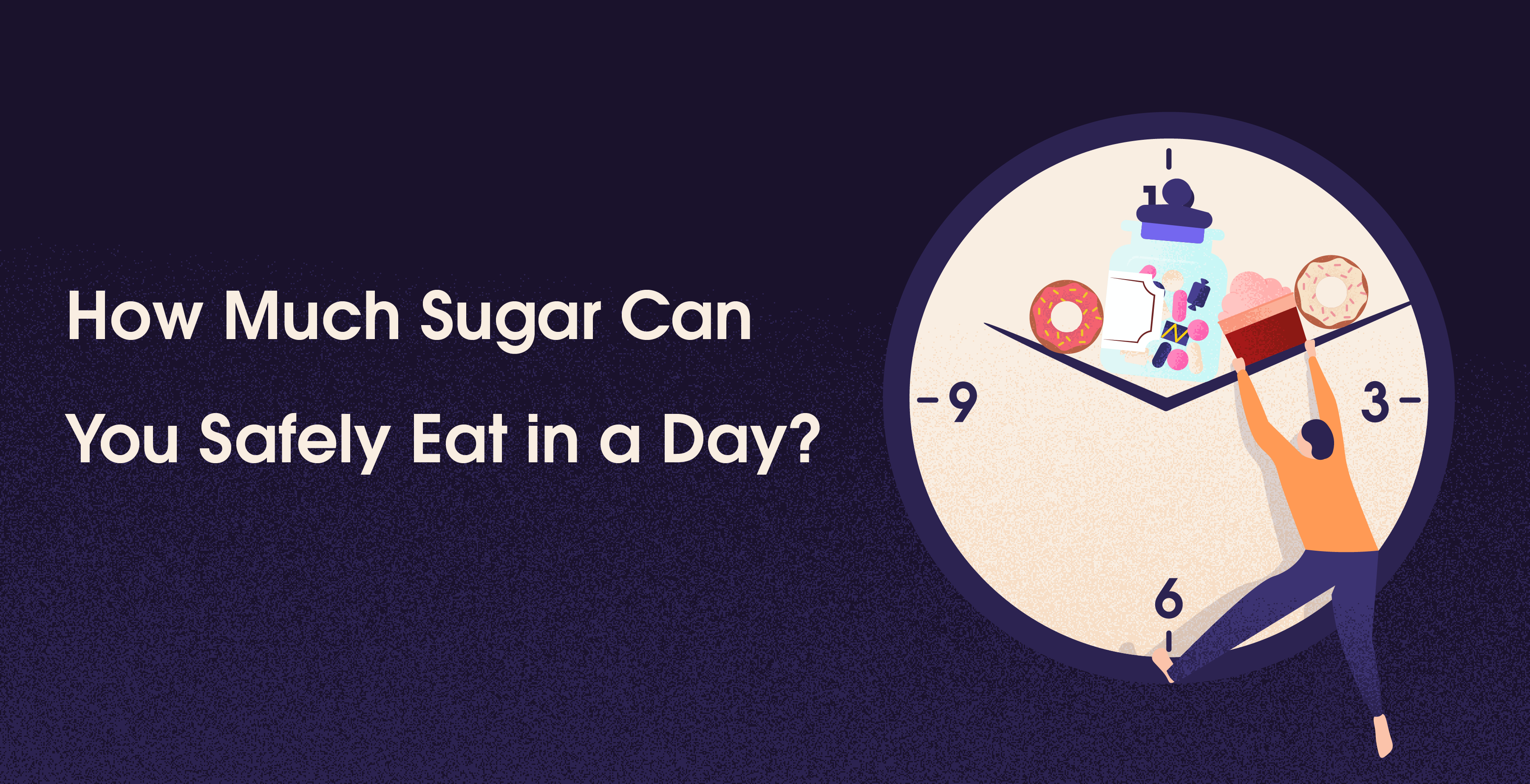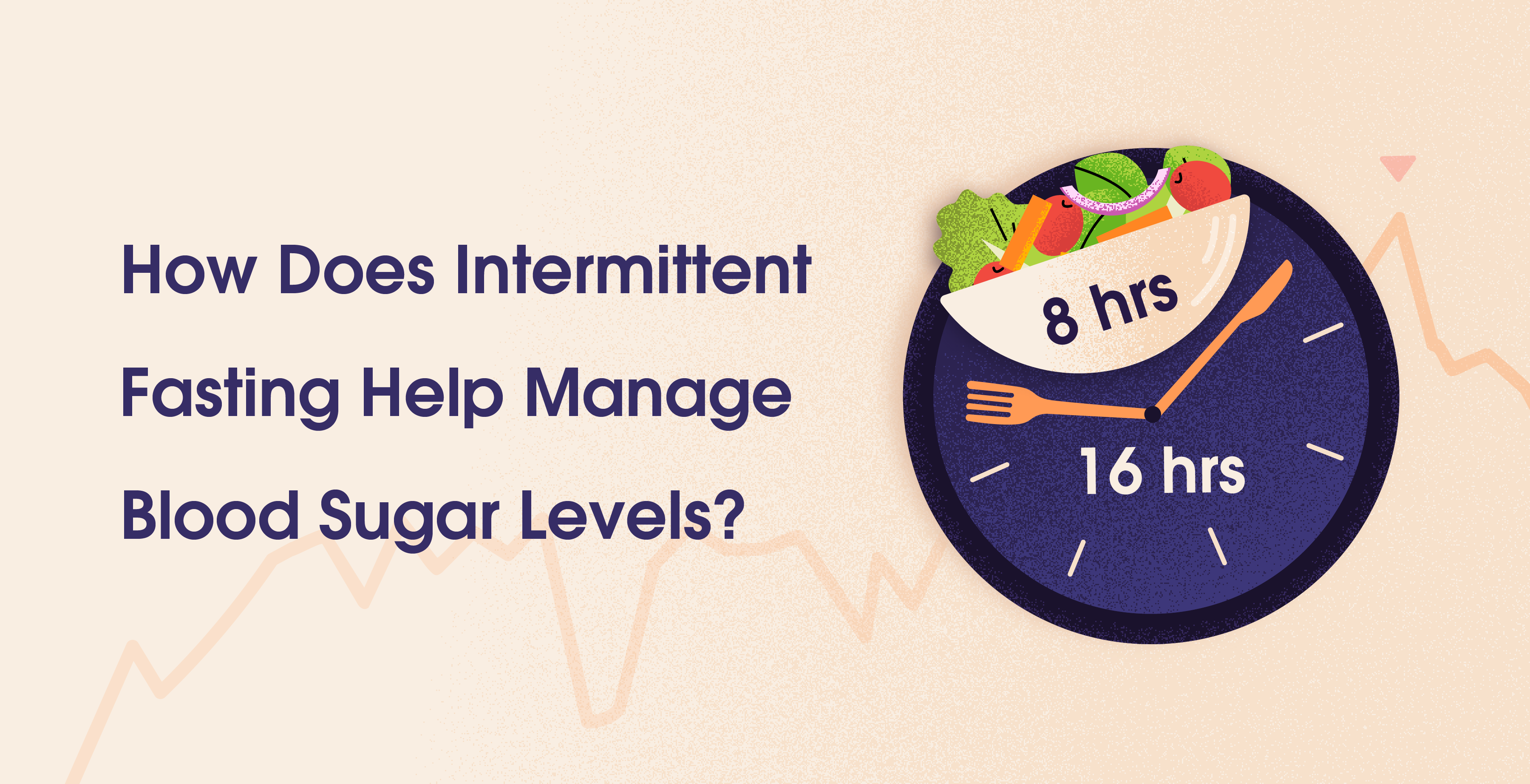Why CGM Is a Game-Changer for a Healthy Lifestyle
Mar 20, 2025
Sayfali Rawlani



Table Of Contents
Most of us are just winging it when it comes to health. We eat what seems like a good choice, exercise when we can, and hope for the best. But how often do we actually know what’s happening inside our bodies? We track our steps, count calories, maybe even monitor heart rate, but blood sugar? That’s usually a mystery—until it isn’t.
That’s where Continuous Glucose Monitoring (CGM) changes the game. It’s not just another wearable or a gimmick—it’s like flipping on a light switch in a dark room. Suddenly, you see patterns, connections, and habits that have been affecting you all along. You finally understand why some days you feel amazing and others you’re exhausted by 3 PM. And once you have that insight, making better choices stops being a guessing game.
Highlights
Most people are unaware of how blood sugar affects their daily energy, mood, and cravings.
CGM provides real-time insights into how food, exercise, sleep, and stress impact glucose levels.
A "healthy" diet isn't universal—CGM helps personalize nutrition based on individual responses.
Blood sugar spikes and crashes lead to fatigue, irritability, and cravings, which CGM helps identify and prevent.
Small adjustments, like pairing carbs with protein or post-meal walks, can stabilize glucose levels.
Different workouts affect blood sugar in unique ways—CGM helps tailor exercise choices for better results.
Stress and poor sleep can significantly impact blood sugar, often without people realizing it.
Even for non-diabetics, stable glucose levels support better energy, focus, and long-term health.
CGM removes the guesswork from maintaining a healthy lifestyle, making improvements easier and more sustainable.
Your Body, Your Rules
Ever had a “healthy” meal that left you starving an hour later? Or a food you swore was good for you but somehow made you sluggish? Maybe your friend swears by intermittent fasting, but when you try it, you feel dizzy and irritable. The truth is, there’s no one-size-fits-all when it comes to nutrition.
That’s what makes CGM so powerful. It shows you your body’s unique response to food, not just some general advice from a wellness blog. Maybe oatmeal spikes your glucose through the roof while eggs keep you steady. Maybe a banana is the perfect pre-workout snack for you but sends someone else on a blood sugar rollercoaster. A CGM helps you fine-tune your diet based on real-time data instead of relying on trial and error.
The Energy Spikes & Crashes
We’ve all been there—crashing hard in the afternoon, barely able to keep our eyes open. You grab a coffee, maybe a sugary snack, and push through. But then the cycle repeats. This isn’t just bad luck; it’s likely blood sugar swings wreaking havoc behind the scenes.
When glucose levels spike too high, your body scrambles to bring them down, often overcorrecting and leaving you feeling drained. A CGM helps you spot these patterns. Maybe that “healthy” smoothie is causing a major spike, or your post-lunch energy slump is tied to what you ate, not just a long day. Once you know, you can make small tweaks—like pairing carbs with protein or taking a short walk after meals—that make a huge difference in keeping energy levels steady.
Tiny Changes, Big Payoff
One of the coolest things about CGM? You don’t have to do anything drastic to see improvements. You’re not committing to some strict, joyless diet. Instead, you’re making small changes that actually work for you.
Maybe you notice that swapping white rice for quinoa keeps your energy stable. Or that eating a handful of almonds before a carb-heavy meal prevents a glucose spike. Maybe walking for 10 minutes after dinner stops that sluggish feeling later in the evening. These aren’t huge lifestyle overhauls—they’re subtle shifts that add up.
And when you see the impact of those small changes in real-time, it’s incredibly motivating. You’re no longer just following advice blindly; you’re learning how your body works and adjusting accordingly.
Exercise: What Works and What Doesn’t
You know that exercise is good for you. But did you know different workouts can have totally different effects on blood sugar?
High-intensity interval training (HIIT), for example, can temporarily spike glucose levels (which isn’t necessarily bad, but it’s good to know). Strength training can improve glucose control over time, while long walks or steady-state cardio might help bring levels down immediately. If you’ve ever felt lightheaded during a workout or completely drained afterward, a CGM can help you understand why—and adjust accordingly.
It’s not just about exercising more; it’s about exercising smarter.
The Overlooked Factors: Stress & Sleep
Most people assume blood sugar is all about food. But stress and sleep play a massive role, too.
Ever had a terrible night’s sleep and found yourself starving the next day? That’s not just in your head. Lack of sleep makes your body more insulin-resistant, meaning it has a harder time processing glucose. Stress does something similar—when you’re anxious, your body releases cortisol, which can spike blood sugar even if you haven’t eaten anything.
A CGM lets you see these connections firsthand. Maybe you realize that your glucose levels are fine all day but spike at night because of stress. Or that after a bad night of sleep, your blood sugar swings more than usual. These insights help you make better decisions—not just about food, but about lifestyle choices that impact overall health.
Why This Matters—Even If You’re “Healthy”
A lot of people assume CGMs are just for diabetics. But here’s the thing—everyone benefits from balanced blood sugar. Keeping glucose stable means better energy, improved focus, fewer cravings, and even better sleep. Over time, it reduces the risk of chronic conditions like insulin resistance, metabolic disorders, and heart disease.
And let’s be real—no one wants to spend their life constantly battling fatigue, mood swings, or brain fog. When you understand what’s happening in your body, you’re not just reacting to problems—you’re preventing them.
The Bottom Line
If you’ve ever wished you could understand why some days you feel great and others you don’t, a CGM might be exactly what you need. It takes the mystery out of nutrition, energy, and well-being, giving you real, actionable insights. No more guessing. No more relying on diet trends that may or may not work for you. Just clear, personalized data that helps you make better choices—without the stress.
Because at the end of the day, the best health plan is the one designed specifically for you.
References
Most of us are just winging it when it comes to health. We eat what seems like a good choice, exercise when we can, and hope for the best. But how often do we actually know what’s happening inside our bodies? We track our steps, count calories, maybe even monitor heart rate, but blood sugar? That’s usually a mystery—until it isn’t.
That’s where Continuous Glucose Monitoring (CGM) changes the game. It’s not just another wearable or a gimmick—it’s like flipping on a light switch in a dark room. Suddenly, you see patterns, connections, and habits that have been affecting you all along. You finally understand why some days you feel amazing and others you’re exhausted by 3 PM. And once you have that insight, making better choices stops being a guessing game.
Highlights
Most people are unaware of how blood sugar affects their daily energy, mood, and cravings.
CGM provides real-time insights into how food, exercise, sleep, and stress impact glucose levels.
A "healthy" diet isn't universal—CGM helps personalize nutrition based on individual responses.
Blood sugar spikes and crashes lead to fatigue, irritability, and cravings, which CGM helps identify and prevent.
Small adjustments, like pairing carbs with protein or post-meal walks, can stabilize glucose levels.
Different workouts affect blood sugar in unique ways—CGM helps tailor exercise choices for better results.
Stress and poor sleep can significantly impact blood sugar, often without people realizing it.
Even for non-diabetics, stable glucose levels support better energy, focus, and long-term health.
CGM removes the guesswork from maintaining a healthy lifestyle, making improvements easier and more sustainable.
Your Body, Your Rules
Ever had a “healthy” meal that left you starving an hour later? Or a food you swore was good for you but somehow made you sluggish? Maybe your friend swears by intermittent fasting, but when you try it, you feel dizzy and irritable. The truth is, there’s no one-size-fits-all when it comes to nutrition.
That’s what makes CGM so powerful. It shows you your body’s unique response to food, not just some general advice from a wellness blog. Maybe oatmeal spikes your glucose through the roof while eggs keep you steady. Maybe a banana is the perfect pre-workout snack for you but sends someone else on a blood sugar rollercoaster. A CGM helps you fine-tune your diet based on real-time data instead of relying on trial and error.
The Energy Spikes & Crashes
We’ve all been there—crashing hard in the afternoon, barely able to keep our eyes open. You grab a coffee, maybe a sugary snack, and push through. But then the cycle repeats. This isn’t just bad luck; it’s likely blood sugar swings wreaking havoc behind the scenes.
When glucose levels spike too high, your body scrambles to bring them down, often overcorrecting and leaving you feeling drained. A CGM helps you spot these patterns. Maybe that “healthy” smoothie is causing a major spike, or your post-lunch energy slump is tied to what you ate, not just a long day. Once you know, you can make small tweaks—like pairing carbs with protein or taking a short walk after meals—that make a huge difference in keeping energy levels steady.
Tiny Changes, Big Payoff
One of the coolest things about CGM? You don’t have to do anything drastic to see improvements. You’re not committing to some strict, joyless diet. Instead, you’re making small changes that actually work for you.
Maybe you notice that swapping white rice for quinoa keeps your energy stable. Or that eating a handful of almonds before a carb-heavy meal prevents a glucose spike. Maybe walking for 10 minutes after dinner stops that sluggish feeling later in the evening. These aren’t huge lifestyle overhauls—they’re subtle shifts that add up.
And when you see the impact of those small changes in real-time, it’s incredibly motivating. You’re no longer just following advice blindly; you’re learning how your body works and adjusting accordingly.
Exercise: What Works and What Doesn’t
You know that exercise is good for you. But did you know different workouts can have totally different effects on blood sugar?
High-intensity interval training (HIIT), for example, can temporarily spike glucose levels (which isn’t necessarily bad, but it’s good to know). Strength training can improve glucose control over time, while long walks or steady-state cardio might help bring levels down immediately. If you’ve ever felt lightheaded during a workout or completely drained afterward, a CGM can help you understand why—and adjust accordingly.
It’s not just about exercising more; it’s about exercising smarter.
The Overlooked Factors: Stress & Sleep
Most people assume blood sugar is all about food. But stress and sleep play a massive role, too.
Ever had a terrible night’s sleep and found yourself starving the next day? That’s not just in your head. Lack of sleep makes your body more insulin-resistant, meaning it has a harder time processing glucose. Stress does something similar—when you’re anxious, your body releases cortisol, which can spike blood sugar even if you haven’t eaten anything.
A CGM lets you see these connections firsthand. Maybe you realize that your glucose levels are fine all day but spike at night because of stress. Or that after a bad night of sleep, your blood sugar swings more than usual. These insights help you make better decisions—not just about food, but about lifestyle choices that impact overall health.
Why This Matters—Even If You’re “Healthy”
A lot of people assume CGMs are just for diabetics. But here’s the thing—everyone benefits from balanced blood sugar. Keeping glucose stable means better energy, improved focus, fewer cravings, and even better sleep. Over time, it reduces the risk of chronic conditions like insulin resistance, metabolic disorders, and heart disease.
And let’s be real—no one wants to spend their life constantly battling fatigue, mood swings, or brain fog. When you understand what’s happening in your body, you’re not just reacting to problems—you’re preventing them.
The Bottom Line
If you’ve ever wished you could understand why some days you feel great and others you don’t, a CGM might be exactly what you need. It takes the mystery out of nutrition, energy, and well-being, giving you real, actionable insights. No more guessing. No more relying on diet trends that may or may not work for you. Just clear, personalized data that helps you make better choices—without the stress.
Because at the end of the day, the best health plan is the one designed specifically for you.
References
Table Of Contents
Table Of Contents
Table Of Contents
Read More


Mar 25, 2025
Sayfali Rawlani


Mar 6, 2025
Sayfali Rawlani


Feb 27, 2025
Sayfali Rawlani



Company
Copyright © 2025 trst health. All right reserved.

